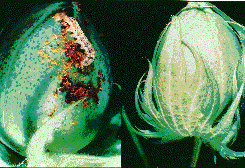Bacillus thuringiensis is a bacterium that parasitizes the caterpillars of some harmful moths and butterflies. Spraying or dusting plants with spores of this bacterium appear to be environmentally safe ways to attack such pests as the gypsy moth, the tent caterpillar, and the tobacco hornworm (which also attacks tomatoes). The bacteria kill by a toxin which they secrete. The gene for this toxin has been introduced into some crop plants in an effort to protect them from insect attack without the need for spraying.

On the left is a cotton boll being attacked by a cotton bollworm. The cotton plant that produced the boll on the right contains and expresses the gene for the Bt toxin. The gene was introduced into the plant by genetic engineering. (Image courtesy of the Monsanto Corp.)
| How transgenic plants are made. |
Transgenic cotton, containing the gene for Bt toxin was widely planted for the first time in 1996. Unfortunately, a substantial fraction of the crop proved not to be resistant to the bollworm.
| Welcome&Next Search |